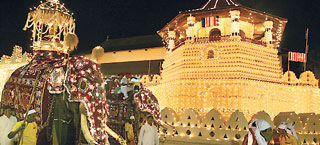It's around 9.15 in the morning. We are at the Sri Dalada Maligawa for a special event. Not many get a chance to participate in offering alms to the Sri Dalada. When such an opportunity comes your way, it's with all devotion and respect that one takes part.
We are awaiting our turn to be called into the enclosure in the upper storey where those responsible for the 'multhan Buddha poojawa' or 'daval aahaara poojawa' - the terms used for the offering of the midday alms to the Tooth Relic, have to sit until the preparations for the offering are finalized. We hear the 'shabda pooja' being held in the lower floor where five musicians play the drums and offer a 'musical offering' to the Sri Dalada.
We are called into the enclosure and asked to sit. The doors of the inner chamber where the Tooth Relic is housed are opened around this time and devotees are permitted to file past the first door of the chamber and view the golden casket with the Tooth Relic. As they pass the door in single file, each person offers white flowers and worships. Two monks arrange the flowers on the table.
When it's closer to the appointed hour for the alms to be offered, the table with the flowers is moved aside and a selected group of 18 from those seated in the enclosure are called in. The men are called in one by one and given the large bowls to which rice has been served and asked to take them into the innermost chamber. The women are given trays with bowls where curries have been served. Each person hands over the silver bowl to one of the two monks present in front of the casket who in turn places each bowl on the table alongside the flowers.
Each devotee is advised not to touch the silver step at the entrance to the inner chamber. As one hands over the bowl and worships the Tooth Relic he or she has to move out making room for the one next in line to come in.
A thick red curtain at the entrance is kept open partially until the offerings are made. By then the others in the party are allowed to come in.
Mothers with new born babies are also allowed in. The little one is kept on the floor in front of the Dalada casket and blessed.
Apart from the rice which is served into six large silver bowls, 32 curries are cooked and offered every day at the midday offering. This is in keeping with the tradition when the king was served with so many curries and the first portions were offered to the Tooth Relic. For the morning 'pooja' eight measures of rice and 18 curries are prepared.
The 'Kariya Karavanarala' is the official responsible for the kitchen arrangements. Months ahead he gives a list of items needed for the 'pooja'.
Five measures of 'kekulu' rice and 32 measures of parboiled red rice as well as 500 grams each of 32 varieties of vegetables are the big items. The list includes 15 coconuts, four bottles of coconut oil, three bottles of treacle, half a measure of salt, 200g turmeric powder, 500g red onions, 200g each of garlic and powdered coriander, 100g each of cumin seed, fenugreek & pepper, 50g of mustard, 250g of sago, 10 ripe 'ambul' plantains, 500g of margarine, 1/4 bottle bee's honey, two kilos sugar, 750g 'sukiri', 250g ginger, 300g sultanas, 500g ginger preserve, a bundle of jaggery, six oranges, six mangoes, one pineapple, 250g sugar and 100g tea. Small quantities of spices have also to be provided. These items have to be handed over to the Maligawa kitchen at least 24 hours earlier and the cooking is done by the kitchen staff.
It is also customary for the party to offer alms to the Maha Sangha after the 'pooja'.
The two Chapters Malwatta and Asgiriya take turns in the task of attending to the rituals.
The Most Venerable Udugama Sri Buddharakkhita Maha Nayaka Thera of the Asgiriya Chapter who was present at the almsgiving delivered a short sermon on the significance of the occasion reminding us that it is a tradition coming down from the days of the ancient kings. It was with a deep sense of satisfaction that we came back having taken part in a ritual dating back many centuries. |


